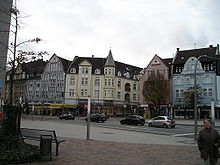
Back Bottrop Afrikaans Bottrop AN بوتروب Arabic Bottrop AST Bottrop AVK Botrop Azerbaijani بتتروپ AZB Bottrop BAN Ботрап Byelorussian Ботроп Bulgarian
Bottrop | |
|---|---|
| Coordinates: 51°31′29″N 06°55′22″E / 51.52472°N 6.92278°E | |
| Country | Germany |
| State | North Rhine-Westphalia |
| Admin. region | Münster |
| District | Urban district |
| Government | |
| • Lord mayor (2020–25) | Bernd Tischler[1] (SPD) |
| Area | |
• Total | 100.7 km2 (38.9 sq mi) |
| Elevation | 60 m (200 ft) |
| Population (2023-12-31)[2] | |
• Total | 118,705 |
| • Density | 1,200/km2 (3,100/sq mi) |
| Time zone | UTC+01:00 (CET) |
| • Summer (DST) | UTC+02:00 (CEST) |
| Postal codes | 46236–46244 |
| Dialling codes | 02041, 02045 |
| Vehicle registration | BOT |
| Website | www |





Bottrop (German pronunciation: [ˈbɔtʁɔp] ⓘ) is a city in west-central Germany, on the Rhine–Herne Canal, in North Rhine-Westphalia. Located in the Ruhr industrial area, Bottrop adjoins Essen, Oberhausen, Gladbeck, and Dorsten. The city had been a coal-mining and rail center and contains factories producing coal-tar derivatives, chemicals, textiles, and machinery. Bottrop grew as a mining center beginning in the 1860s, was chartered as a city in 1921, and bombed during the Oil Campaign of World War II. In 1975, it unified with the neighbouring communities of Gladbeck and Kirchhellen, but Gladbeck left it in 1976, leading to Kirchhellen becoming a district of Bottrop as Bottrop-Kirchhellen. It is also twinned with Blackpool, England.
- ^ Wahlergebnisse in NRW Kommunalwahlen 2020, Land Nordrhein-Westfalen, accessed 19 June 2021.
- ^ "Bevölkerung der Gemeinden Nordrhein-Westfalens am 31. Dezember 2023 – Fortschreibung des Bevölkerungsstandes auf Basis des Zensus vom 9. Mai 2011" (in German). Landesbetrieb Information und Technik NRW. Retrieved 2024-06-20.




